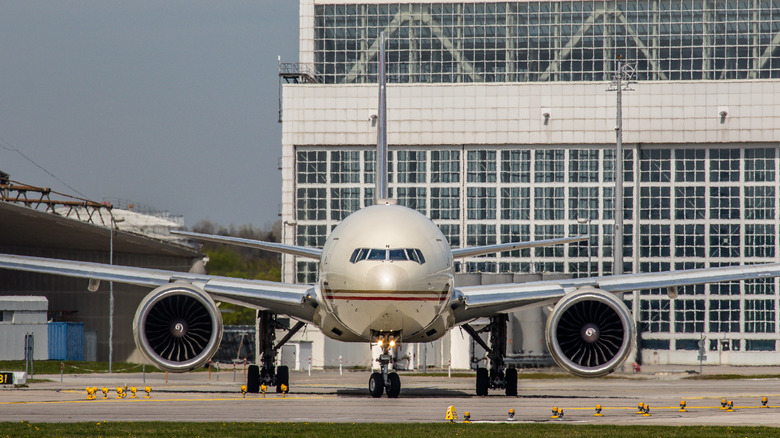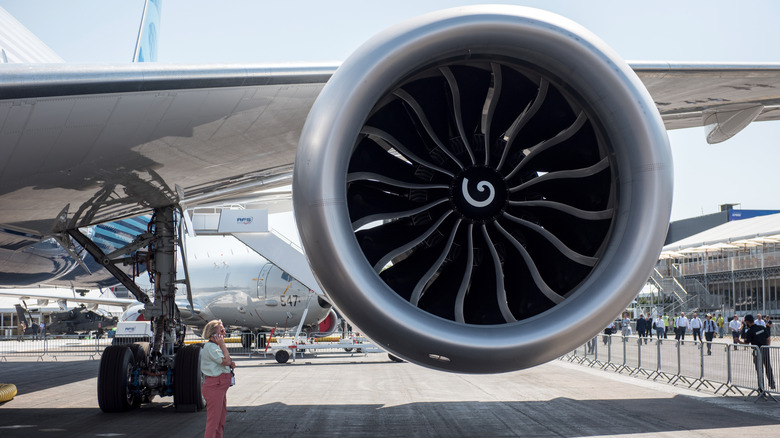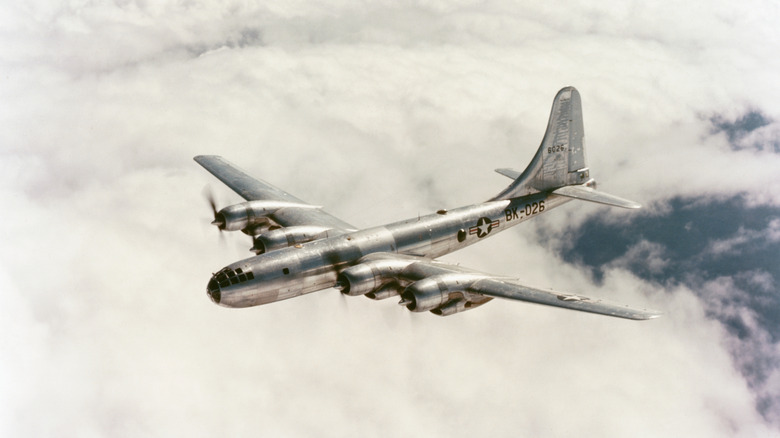
Andreas Haas/Getty Images
If you've ever stood near a runway and watched planes take to the skies, you've probably also been awestruck by the sheer size of the engines that make it all possible. On large commercial planes, engines are often the most distinctive part, clearly identifiable, thanks to their appearance and large size. And modern-day jet engines come in various shapes and sizes. But have you ever wondered which is the largest engine ever to be put on a plane? Our quest to answer this question yielded interesting results.
If you're here for a no-nonsense, quick answer, the largest engine (in terms of physical size) to ever be attached to an aircraft is the General Electric GE9X, set to be exclusively used on the upcoming Boeing 777X. There is a slight catch attached to this claim, though. While the GE9X is — without a doubt — the largest engine ever put on a plane; as of 2025, the sole GE9X-powered aircraft (the Boeing 777X) won't enter commercial service before 2026. That said, several test flights on aircraft powered by these upcoming GE9X engines have taken place, with the first flight dating back to 2018.
That brings us to the next question. What is the largest engine to ever make it to an aircraft that is currently operational — or had been operational at some point in history? Well, the answer to that question is the incredible General Electric GE90. If that name sounds eerily similar to the GE9X, it is because the GE90 is its predecessor.
General Electric GE9X and GE90 engines: The largest jet engines to ever exist

John Keeble/Getty Images
There is no debate here. The GE9X and its older sibling — the GE90 — are the biggest, most powerful jet engines ever fixed to an aircraft. In terms of sheer physical size, the differences between the GE9X and the GE90 are marginal. For example, the fan used on the GE9X — at 134 inches — is only 6 inches longer than the 128-inch fans used on the GE90. The 134-inch fan on the GE9X also makes it the largest fan ever used in commercial aviation. Another key difference between the two is the number of fan blades. The GE9X has fewer fan blades (16) compared to 22 on the GE90.
In terms of length, at 287 inches, the older GE90 is significantly longer than the newer GE9X, which measures 220 inches across. As for weight, the GE9X, at 21,000 lbs, is only marginally heavier than the heaviest variant of the GE90 engine (the GE90-115B), which weighs 19,316 lbs.
The optimizations made to the GE9X over the GE90 also help it generate significantly greater amounts of thrust. During testing, the GE9X has managed to generate an astounding 134,300 pounds of thrust, making it the most powerful jet engine ever built. This output surpasses the 115,300 pounds of thrust generated by the GE90. However before you jump the gun and declare the GE9X as the winner, the certified maximum thrust for the GE9X for commercial operation is 105,000 pounds, which makes it slightly less powerful than the GE90 for commercial operations.
What is the largest piston engine ever to be used on an aircraft?
Though the GE9X and GE90 have established themselves as the largest, most powerful engines (of any type) to be put on an airplane, it is essential to note that these are gas turbine engines (more commonly known as jet engines). Gas turbine engines (which include turbojets, turbofans, turboprops, and turboshafts) have completely different technology compared to piston engines (often confused with turboprops), which are widely used today in smaller planes. Given this fundamental difference, we set out to identify the true heavyweight champion among aircraft piston engines — and that search led us to the Lycoming XR-7755-3.
The XR-7755-3 was designed and manufactured by noted piston aircraft engine maker Lycoming during the height of World War II at the request of the U.S. Air Force. The demand from the Air Force was for a high take-off power, fuel-efficient engine that would find its home in a yet-to-be-designed long-range bomber and transport aircraft. Development on the Lycoming XR-7755-3 began in early 1944, and by the time the first prototypes were ready in 1946, World War II came to an abrupt end. Only three prototypes were ever built.
Everything about the XR-7755-3 was massive. This 36-cylinder, liquid-cooled engine had a diameter of 61 inches and a length of 121.35 inches. It had a displacement of 7,755 cubic inches and made a colossal 5,000 hp of power at 2,600 RPM, which were great numbers at the time. As impressive as these numbers were, only three working prototypes of the Lycoming XR-7755-3 were ever made, and the engine never actually made it into an aircraft that would take to the skies.
Pratt & Whitney R-4360 Wasp Major: The largest piston engine to ever fly

Museum Of Flight Foundation/Getty Images
While the Lycoming XR-7755-3 remains the largest piston engine to be ever built, as explained earlier, it never made it into an actual plane. The next obvious question, therefore, was to determine which was the largest piston engine to power a plane that actually took off. This led us to the Pratt & Whitney R-4360 Wasp Major.
In terms of sheer size and power output, the Wasp Major couldn't hold a candle to the Lycoming XR-7755-3. This engine had 28 cylinders, a diameter of 55 inches, and a length of 96.5 inches while weighing 3,870 lbs. It had a power output of 4,300 hp, making it only slightly less powerful than the Lycoming engine. Where the Wasp Major truly blew the Lycoming engine away was in terms of popularity and usage.
Despite being developed at around the same time as the larger Lycoming, the Wasp Major was a massive success for Pratt & Whitney. Between 1944 and 1955, the company made 18,697 units of the Wasp Major. The engine would go on to power a wide variety of airplanes ranging from the Boeing B-50 Superfortress (an improved B-29 Superfortress) and the Boeing KC-97 Stratofreighter to the Boeing 377 Stratrocruiser and the Northrop YB-35. To this day, it remains the largest piston engine to be ever put on a plane that took to the skies.
.png)




